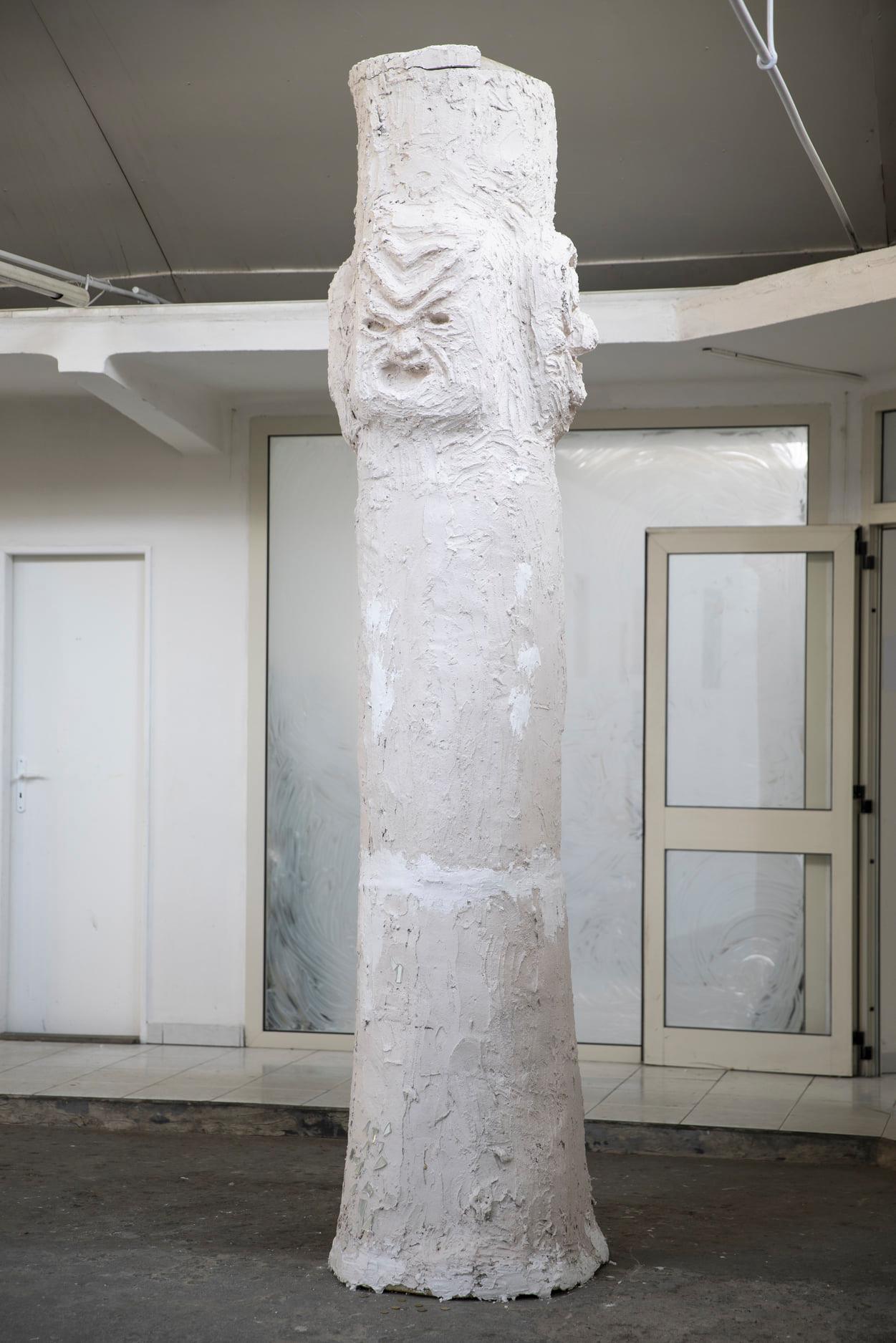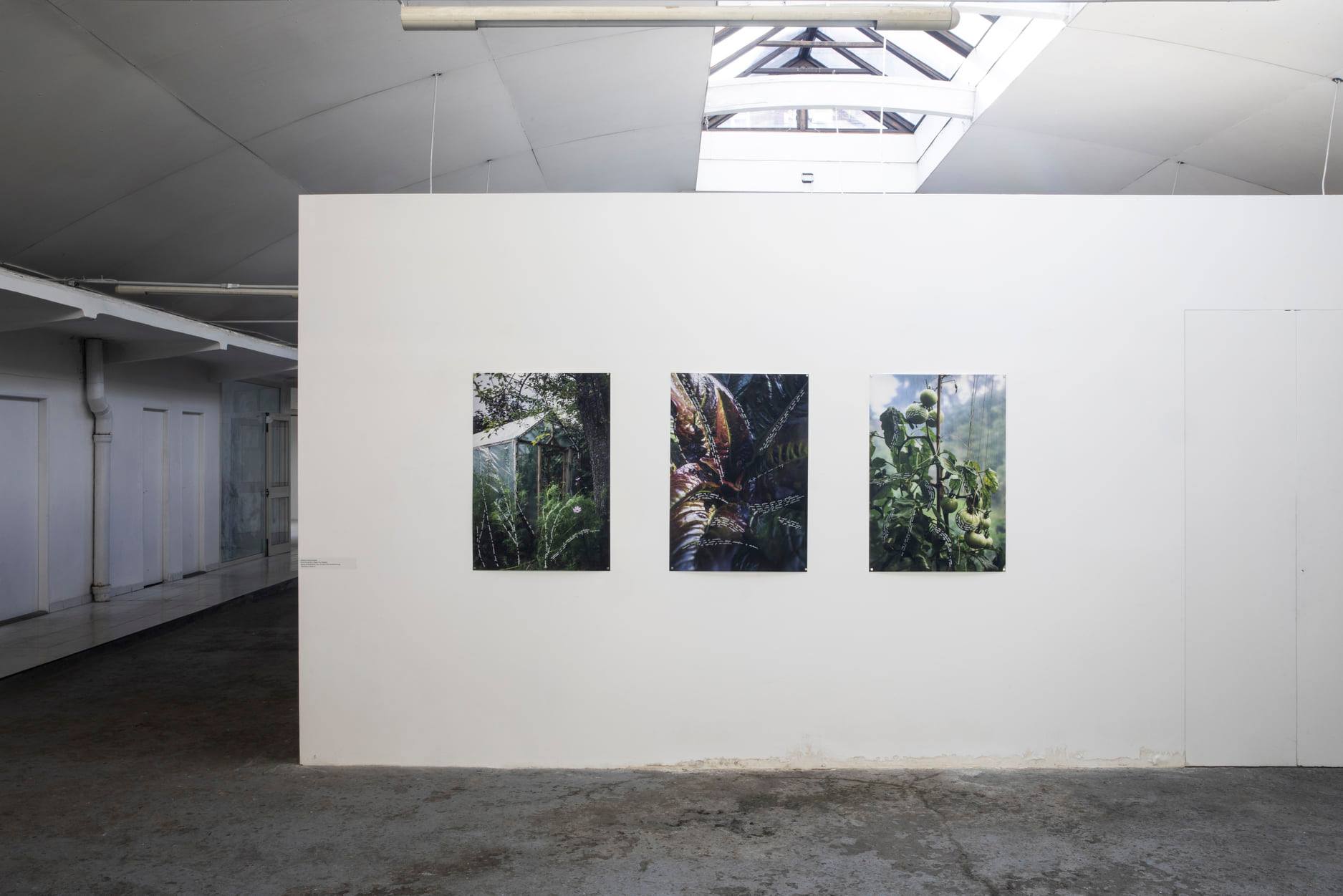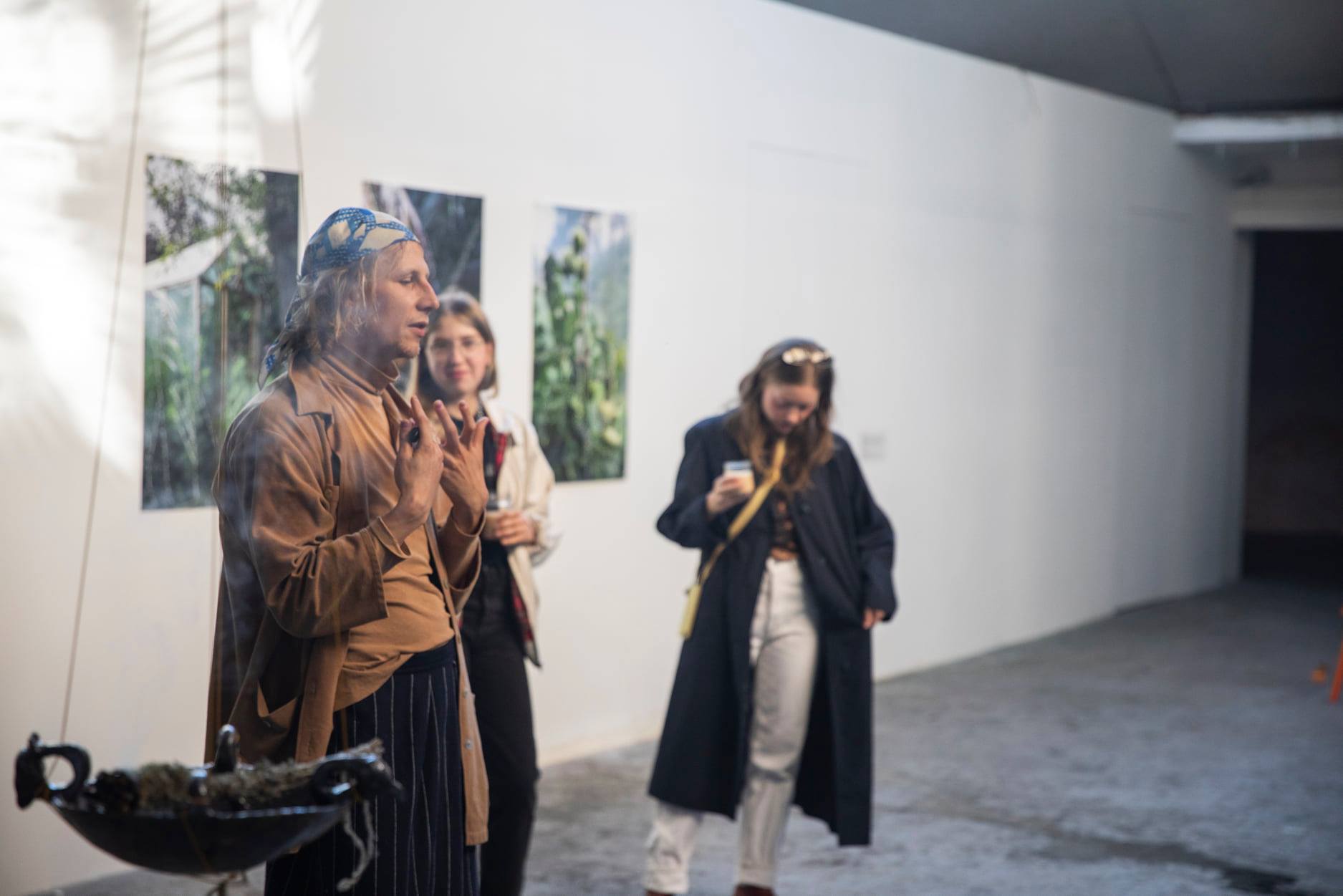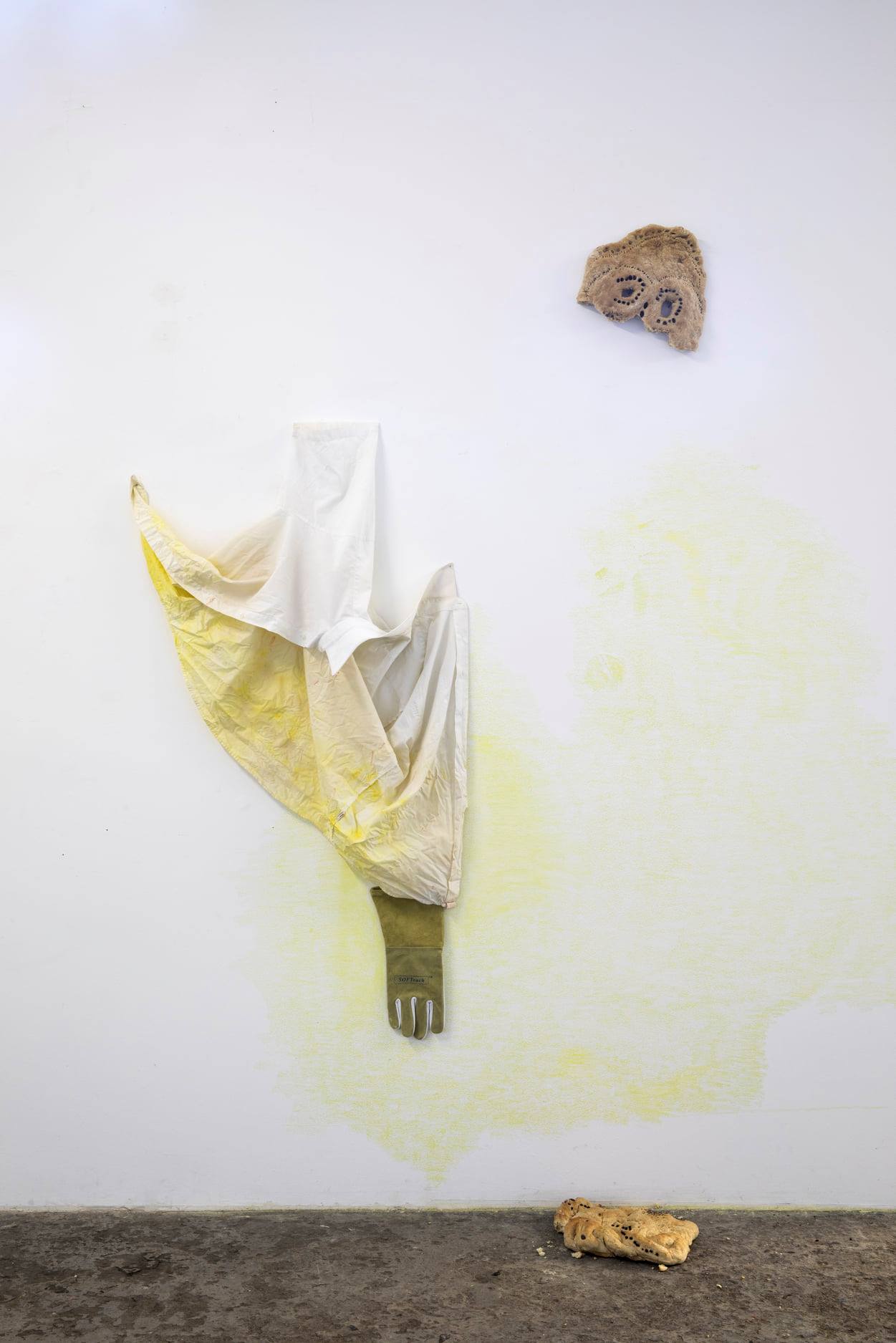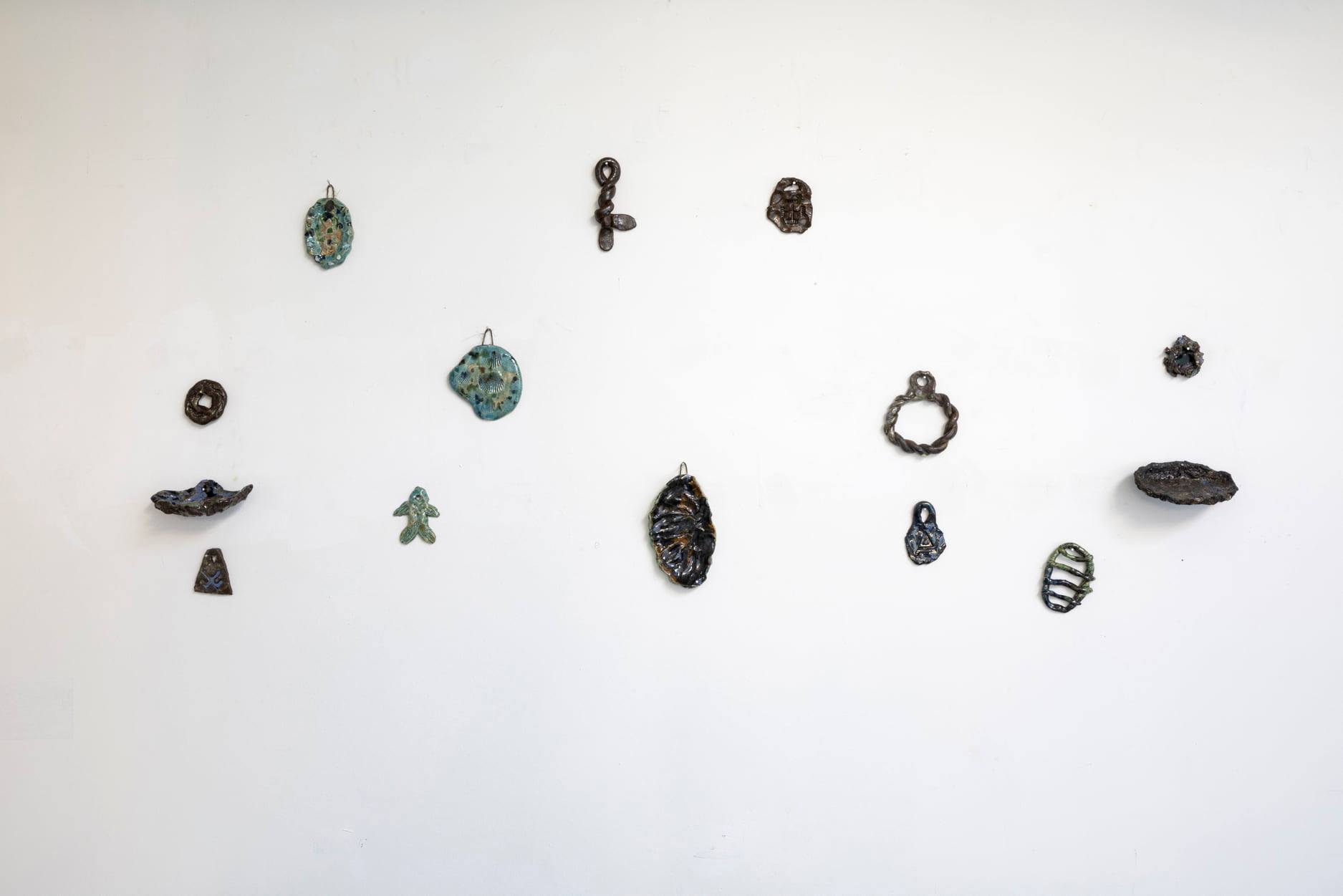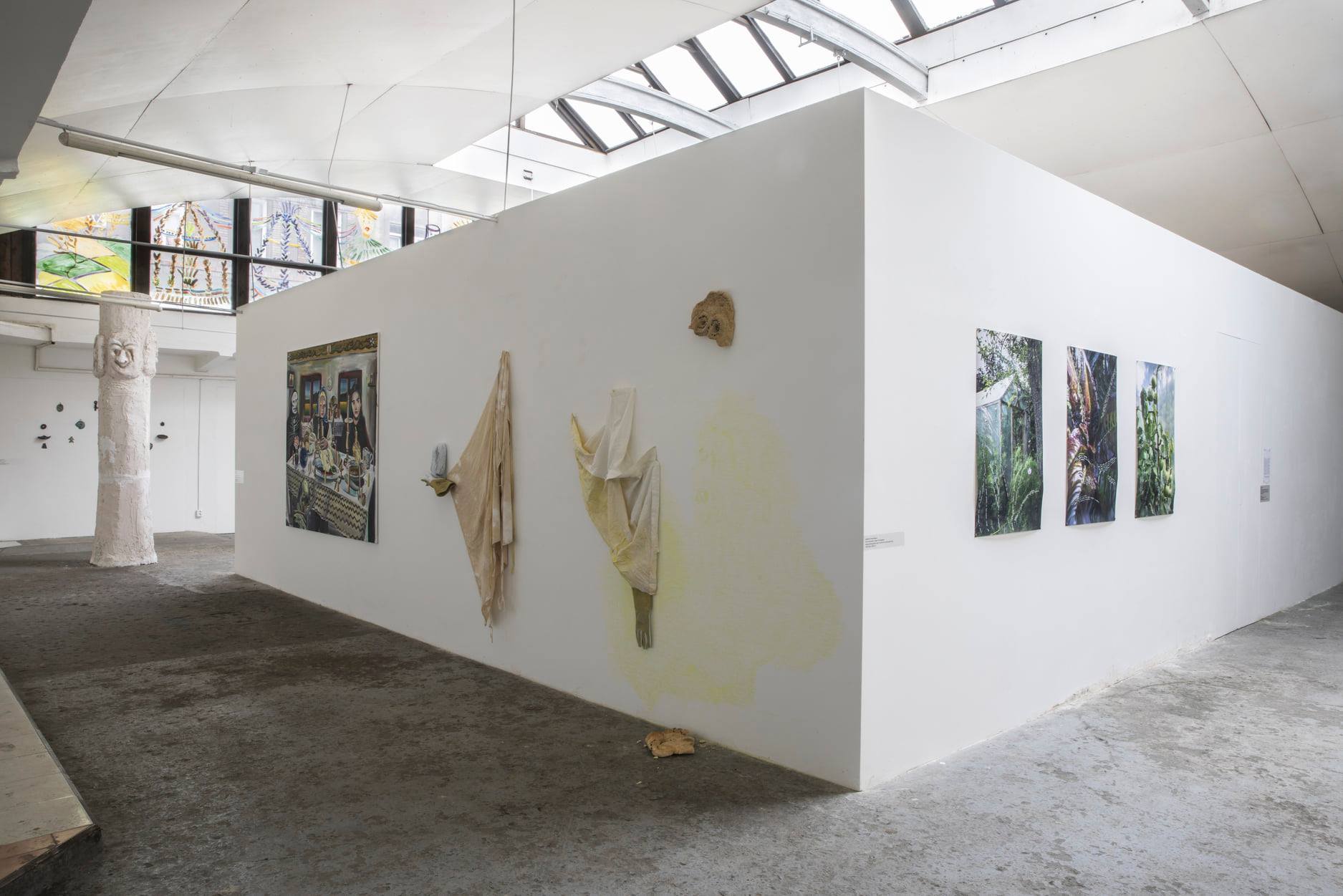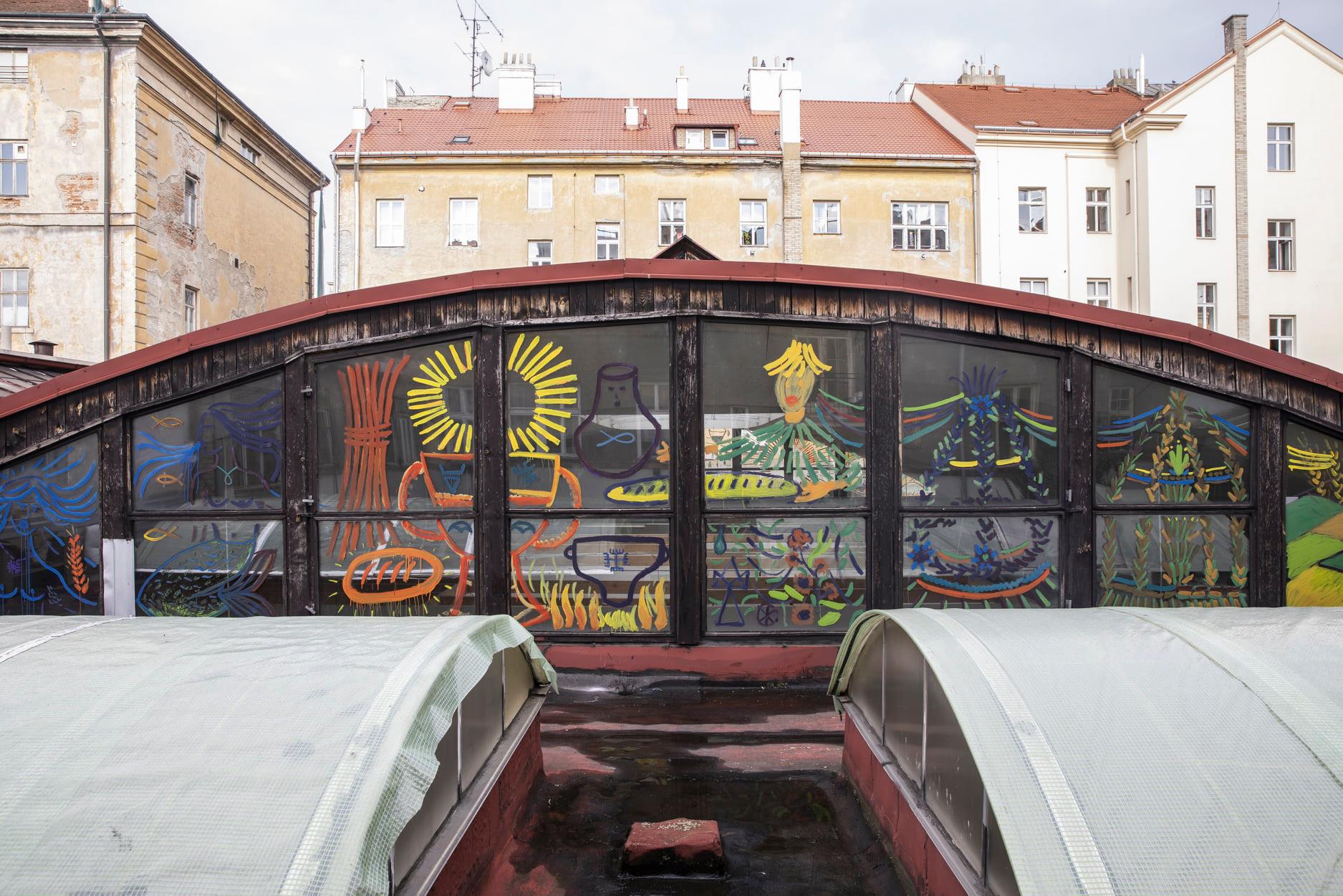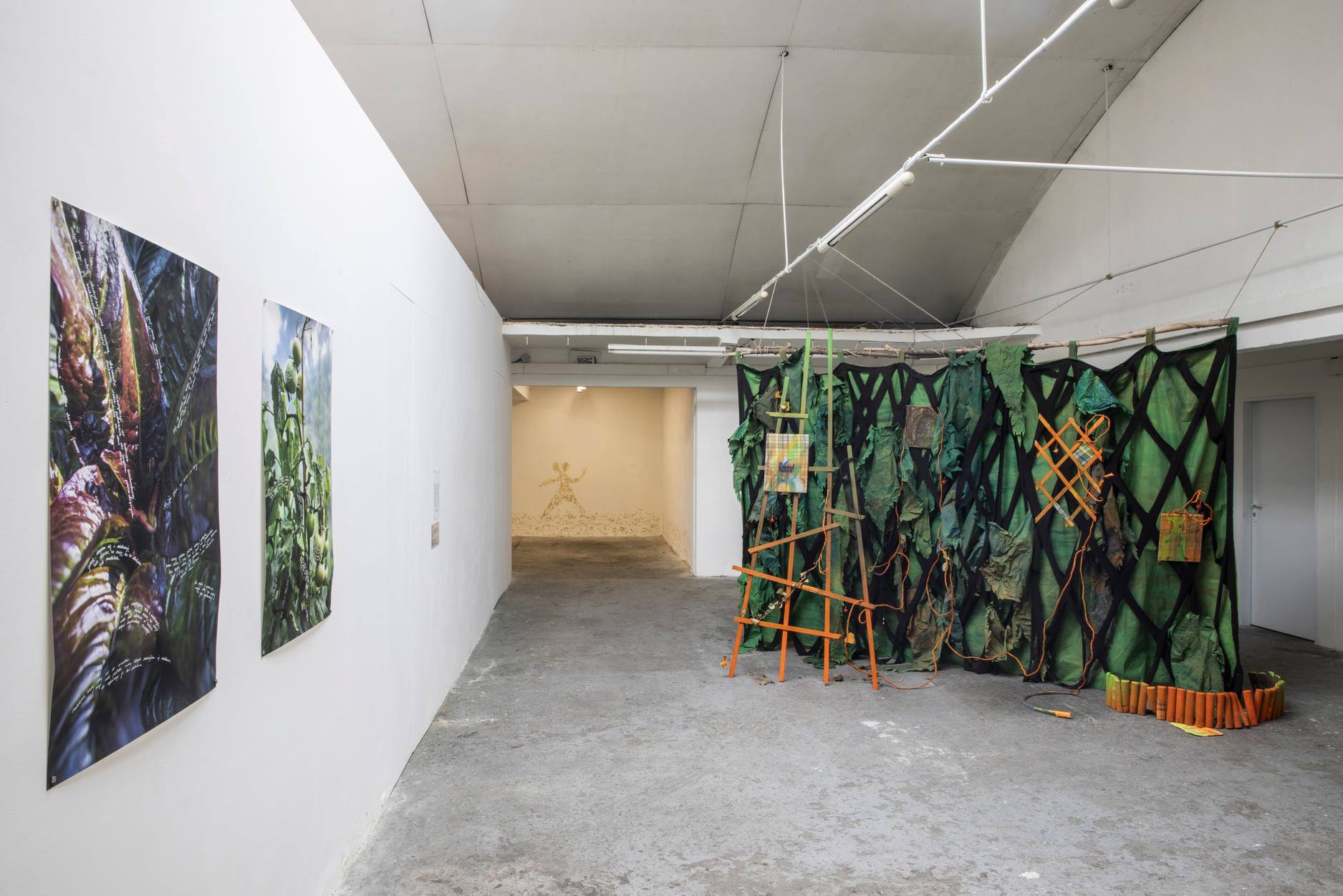Apostasia: Rituals of Letting Go
curated by: Tomek Pawłowski Jarmołajew
artists: Veronika Čechmanková, Yen Chun Lin, Adelina Cimochowicz, Jagoda Dobecka, Zeynab Gueye, Klara Jakes, Zuza Koszuta, Olga Krykun, Maryna Sakowska, Tereza Silon, Stony Tellers, Dominika Święcicka, Alicja Wysocka, Jan Vytiska
2.9. - 28.10. 2021
ENG/ The group exhibition presents works in different media by emerging artists from Czech Republic, Poland and Germany that refer to folk and indigenous traditions, beliefs and crafts, magical thinking and animism, using the language of poetry, speculative theories and storytelling. Using these various approaches and narratives the artists explore topics related to letting go, unlearning, loss or mourning in the context of the individual and collective traumas. The artists presented at the exhibition look for ways out and a sense of relief by reclaiming agency through everyday, imagined and forgotten rituals and exploring the visuality, symbolism and cultural codes of various ceremonies. Thus, the exhibition space evokes a place of an abandoned ritual or a cult’s temple to unidentified goddesses, giving strength and awareness in dealing with reality.
The title Apostasia is a genus of orchid species and could also be associated with apostasy - an act of leaving the Catholic Church. This bureaucratic process has a political and symbolic dimension, especially in the Polish context, where this institution has exceptional strength and power. Apostasy is one of the examples of a resignation strategy, an exit, where a personal decision is a liberating act of resistance against institutional violence. The exhibition also evokes other areas and contexts within which the artists undertake letting go, or the stories related to experiencing loss.
One of the ways to deal with oppressive structures and look for alternatives is to turn towards unorthodox knowledge systems, such as astrology, conspiracy theories, or folk beliefs. For centuries people without any power seeking for agency have been using these tools for translating reality and enchanting it. Another way to deal with oppression is the need to connect with nature, which is a response to technological exhaustion, exploitation and multidimensional crisis. These trends became more visible by the pandemic, which has accelerated already existing inequalities and populism, leaving masses of people with an even more acute sense of helplessness and hopelessness. In this context, reaching for rituals and magical thinking can be a recipe for uncertain times.The exhibition is a result of curatorial residency undertaken by Tomek Pawłowski-Jarmołąjew hosted by two months in summer 2021 in Garage Gallery residential program.
1.
In the depth of galaxy the creatures can sense all the variations of the glyptodon spirit.
Embrace your soul and immerse yourself in the mythical experience.
You can be anywhere.
You can be anything.
You can crumble like the skeleton of the magnificent glyptodon.
- text by Ester Grohova accompanying the work of Olga Krykun Glyptodon Expert Interview
2.
My unquestionably privileged circumstances of living in a house with a garden made my experience of self-isolation much easier than that suffered by people locked up in the four walls of a city flat. We had begun working the garden right before the first government restrictions were imposed. Once restrictions began applying, we attempted to shed all fear brought by the new situation by delving deep into the joy of watching early radish, kohlrabi and rhubarb shoots. As weeks flew by with unnerving speed, we set up a vegetable bed and raised a permaculture bed in the garden, and built a timber frame greenhouse. Over recent days, we used materials found in the nearby residential area to develop a new large composter with herb flowerpots. Throughout that time, I was touched and excited to take photographs of our sprouting peas and the charmingly named and freshly planted purple scarlet kale, posting snapshots online.
I kept saying out loud over and over: isn’t it pleasant to burrow in soil, isn’t it relaxing to work in the garden? Something I would be inclined to loftily refer to as a form of resistance might well stand for nothing else but a “reductionist and hedonist healthcare model”. I confer assorted meanings upon my so-called practice and adorn them with words, making them part of the trend I have chosen as my own. Yet I primarily seek satisfaction in the visual representation of my actions, having embarked on
a quest for the swift fulfilment of a yearning for pleasure, reborn immediately upon having been quenched. I find myself in a closed loop. Yet again, I repeat someone else’s words: I want to develop relations with the beings in my garden. What I actually feel are emotions tied in with the impact of these words – how they may be received and what they say about me. Who do I become having decided that picking slugs off radishes is the most important thing at this point in time? And how will all these very important others see the person I have become?
I don‘t like meditation, I can‘t stand the presence of meditation in western culture, the cult of yoga, its cultural appropriation, the stories of listening to oneself, the journeys into the oneself leading only to the bottom of relationships. I want to pray and I do it even though I am still ashamed to talk about it. I cook, focus, and relax at the same time so deeply that I feel that is what prayer is. I feel the deepest sense possible and I believe, firmly believe that my body is just in the middle of something most right. Similarly, when I am doing something in the garden: my body repeats the movements I have recently learned, but it does them without hesitation. And then I am full of faith, calm. I am sure and there is nothing solemn about it. I feel a soothing chill up my cheek, and where my nails meet my cuticles, I have indelible particles of soil. There is no depth, I don‘t know myself any better. I don‘t think about the boundaries of my body, much less its representation. Yet I fear I will disappear. I feel that In the eyes of others I am too often just a representation. I tear myself away from the stillness of wholeness and with a shred of my own I click the circle that will create a picture on my phone. Look: this is so beautiful and I took care of it! I am bursting with pride, look!
- translation of the writings by Adelina Cimochowicz as part of the work I, Gaea, The Naeked
3.
THE CURE FOR BURNOUT
300 ml of transparent working conditions
0,04 ml of an employment contract
5 cubes of openness to the critic
no free labour
IT IS NOT SELF-CARE
300 ml of care and self-care
6 cubes of higher fees
3 spoons of transparency
ability to discuss negative situations
THERAPY FOR SADNESS
300 ml of kindness
0,04 of diversity
5 cubes of solidarity
3 spoons of empathy
inclusion
tears
- Apostasia Coctail Bar - cocktails composed by StonyTellers
CZ/ Výstava „Apostasia: Rituals of Letting Go“ je výsledkem kurátorské rezidence Tomka Pawłowského- Jarmołąjewa v galerii Garage Gallery v létě 2021. Skupinová výstava představuje díla z rozdílných médií od převážně začínajících mladých umělců z České republiky, Polska a Německa, kteří se odkazují k lidovým a původním tradicím, vírám a řemeslům, magickému myšlení a animismu, poetickému jazyku a vyprávění. Pomocí různých způsobů vyprávění, zkoumají umělci témata opuštění, odučení, ztráty nebo smutku v kontextu individuálních a kolektivních traumat. V rámci této výstavy zkoumají východiska a pocity úlevy a získávají zpět své místo pomocí každodenních, imaginárních a zapomenutých rituálů. Zkoumají vizualitu, symboliku a kulturní kódy rozdílných obřadů. Výstavní prostor tedy evokuje místo opuštěného rituálního místa či chrámu neurčitých bohyní a dává sílu a vědomí při jednání s realitou.
Termín Apostasia označuje druh orchidejí a je také spojován s apostází, termínem označujícím odstoupení od katolické církve. Tento byrokratický proces má politický a také symbolický rozměr, zejména v polském kontextu, kde má tato instituce výjimečnou sílu a moc. Apostáze je jedním z příkladů rezignace a odchodu, kdy je osobní rozhodnutí osvobozujícím aktem odporu proti institucionalizovanému násilí. Výstava evokuje také další oblasti, které se umělci zavazují opustit a příběhy související se prožíváním ztráty.
Jedním ze způsobů, jak se vypořádat s represivními strukturami a hledat alternativy, je obrátit se k neortodoxním znalostním systémům, jako je astrologie, konspirační teorie nebo lidová víra. Lidé bez jakékoli moci hledající své místo, používají po staletí tyto nástroje k překládání reality a k jejímu okouzlování. Dalším způsobem, jak se vypořádat s útlakem, je potřeba spojení s přírodou, která je reakcí na technologické vyčerpání, vykořisťování a multidimenzionální krizi. Tyto trendy se staly viditelnějšími právě kvůli pandemii, která urychlila již existující nerovnosti a populismus, takže masy lidí mají ještě akutnější pocit bezmoci a beznaděje. V této souvislosti může být dosažení rituálů a magického myšlení receptem na nejisté časy.
Účast Adeliny Cimochowicz, Maryny Sakowské a Alicji Wysocké byla realizována za podpory Institutu Adama Mickiewicze z programu „Polská kultura na celém světě“.
photos by: Světlana Malinová
graphic design: Matěj Martinec, Matúš Buranovský
curated by: Tomek Pawłowski Jarmołajew
artists: Veronika Čechmanková, Yen Chun Lin, Adelina Cimochowicz, Jagoda Dobecka, Zeynab Gueye, Klara Jakes, Zuza Koszuta, Olga Krykun, Maryna Sakowska, Tereza Silon, Stony Tellers, Dominika Święcicka, Alicja Wysocka, Jan Vytiska
2.9. - 28.10. 2021
ENG/ The group exhibition presents works in different media by emerging artists from Czech Republic, Poland and Germany that refer to folk and indigenous traditions, beliefs and crafts, magical thinking and animism, using the language of poetry, speculative theories and storytelling. Using these various approaches and narratives the artists explore topics related to letting go, unlearning, loss or mourning in the context of the individual and collective traumas. The artists presented at the exhibition look for ways out and a sense of relief by reclaiming agency through everyday, imagined and forgotten rituals and exploring the visuality, symbolism and cultural codes of various ceremonies. Thus, the exhibition space evokes a place of an abandoned ritual or a cult’s temple to unidentified goddesses, giving strength and awareness in dealing with reality.
The title Apostasia is a genus of orchid species and could also be associated with apostasy - an act of leaving the Catholic Church. This bureaucratic process has a political and symbolic dimension, especially in the Polish context, where this institution has exceptional strength and power. Apostasy is one of the examples of a resignation strategy, an exit, where a personal decision is a liberating act of resistance against institutional violence. The exhibition also evokes other areas and contexts within which the artists undertake letting go, or the stories related to experiencing loss.
One of the ways to deal with oppressive structures and look for alternatives is to turn towards unorthodox knowledge systems, such as astrology, conspiracy theories, or folk beliefs. For centuries people without any power seeking for agency have been using these tools for translating reality and enchanting it. Another way to deal with oppression is the need to connect with nature, which is a response to technological exhaustion, exploitation and multidimensional crisis. These trends became more visible by the pandemic, which has accelerated already existing inequalities and populism, leaving masses of people with an even more acute sense of helplessness and hopelessness. In this context, reaching for rituals and magical thinking can be a recipe for uncertain times.The exhibition is a result of curatorial residency undertaken by Tomek Pawłowski-Jarmołąjew hosted by two months in summer 2021 in Garage Gallery residential program.
1.
In the depth of galaxy the creatures can sense all the variations of the glyptodon spirit.
Embrace your soul and immerse yourself in the mythical experience.
You can be anywhere.
You can be anything.
You can crumble like the skeleton of the magnificent glyptodon.
- text by Ester Grohova accompanying the work of Olga Krykun Glyptodon Expert Interview
2.
My unquestionably privileged circumstances of living in a house with a garden made my experience of self-isolation much easier than that suffered by people locked up in the four walls of a city flat. We had begun working the garden right before the first government restrictions were imposed. Once restrictions began applying, we attempted to shed all fear brought by the new situation by delving deep into the joy of watching early radish, kohlrabi and rhubarb shoots. As weeks flew by with unnerving speed, we set up a vegetable bed and raised a permaculture bed in the garden, and built a timber frame greenhouse. Over recent days, we used materials found in the nearby residential area to develop a new large composter with herb flowerpots. Throughout that time, I was touched and excited to take photographs of our sprouting peas and the charmingly named and freshly planted purple scarlet kale, posting snapshots online.
I kept saying out loud over and over: isn’t it pleasant to burrow in soil, isn’t it relaxing to work in the garden? Something I would be inclined to loftily refer to as a form of resistance might well stand for nothing else but a “reductionist and hedonist healthcare model”. I confer assorted meanings upon my so-called practice and adorn them with words, making them part of the trend I have chosen as my own. Yet I primarily seek satisfaction in the visual representation of my actions, having embarked on
a quest for the swift fulfilment of a yearning for pleasure, reborn immediately upon having been quenched. I find myself in a closed loop. Yet again, I repeat someone else’s words: I want to develop relations with the beings in my garden. What I actually feel are emotions tied in with the impact of these words – how they may be received and what they say about me. Who do I become having decided that picking slugs off radishes is the most important thing at this point in time? And how will all these very important others see the person I have become?
I don‘t like meditation, I can‘t stand the presence of meditation in western culture, the cult of yoga, its cultural appropriation, the stories of listening to oneself, the journeys into the oneself leading only to the bottom of relationships. I want to pray and I do it even though I am still ashamed to talk about it. I cook, focus, and relax at the same time so deeply that I feel that is what prayer is. I feel the deepest sense possible and I believe, firmly believe that my body is just in the middle of something most right. Similarly, when I am doing something in the garden: my body repeats the movements I have recently learned, but it does them without hesitation. And then I am full of faith, calm. I am sure and there is nothing solemn about it. I feel a soothing chill up my cheek, and where my nails meet my cuticles, I have indelible particles of soil. There is no depth, I don‘t know myself any better. I don‘t think about the boundaries of my body, much less its representation. Yet I fear I will disappear. I feel that In the eyes of others I am too often just a representation. I tear myself away from the stillness of wholeness and with a shred of my own I click the circle that will create a picture on my phone. Look: this is so beautiful and I took care of it! I am bursting with pride, look!
- translation of the writings by Adelina Cimochowicz as part of the work I, Gaea, The Naeked
3.
THE CURE FOR BURNOUT
300 ml of transparent working conditions
0,04 ml of an employment contract
5 cubes of openness to the critic
no free labour
IT IS NOT SELF-CARE
300 ml of care and self-care
6 cubes of higher fees
3 spoons of transparency
ability to discuss negative situations
THERAPY FOR SADNESS
300 ml of kindness
0,04 of diversity
5 cubes of solidarity
3 spoons of empathy
inclusion
tears
- Apostasia Coctail Bar - cocktails composed by StonyTellers
CZ/ Výstava „Apostasia: Rituals of Letting Go“ je výsledkem kurátorské rezidence Tomka Pawłowského- Jarmołąjewa v galerii Garage Gallery v létě 2021. Skupinová výstava představuje díla z rozdílných médií od převážně začínajících mladých umělců z České republiky, Polska a Německa, kteří se odkazují k lidovým a původním tradicím, vírám a řemeslům, magickému myšlení a animismu, poetickému jazyku a vyprávění. Pomocí různých způsobů vyprávění, zkoumají umělci témata opuštění, odučení, ztráty nebo smutku v kontextu individuálních a kolektivních traumat. V rámci této výstavy zkoumají východiska a pocity úlevy a získávají zpět své místo pomocí každodenních, imaginárních a zapomenutých rituálů. Zkoumají vizualitu, symboliku a kulturní kódy rozdílných obřadů. Výstavní prostor tedy evokuje místo opuštěného rituálního místa či chrámu neurčitých bohyní a dává sílu a vědomí při jednání s realitou.
Termín Apostasia označuje druh orchidejí a je také spojován s apostází, termínem označujícím odstoupení od katolické církve. Tento byrokratický proces má politický a také symbolický rozměr, zejména v polském kontextu, kde má tato instituce výjimečnou sílu a moc. Apostáze je jedním z příkladů rezignace a odchodu, kdy je osobní rozhodnutí osvobozujícím aktem odporu proti institucionalizovanému násilí. Výstava evokuje také další oblasti, které se umělci zavazují opustit a příběhy související se prožíváním ztráty.
Jedním ze způsobů, jak se vypořádat s represivními strukturami a hledat alternativy, je obrátit se k neortodoxním znalostním systémům, jako je astrologie, konspirační teorie nebo lidová víra. Lidé bez jakékoli moci hledající své místo, používají po staletí tyto nástroje k překládání reality a k jejímu okouzlování. Dalším způsobem, jak se vypořádat s útlakem, je potřeba spojení s přírodou, která je reakcí na technologické vyčerpání, vykořisťování a multidimenzionální krizi. Tyto trendy se staly viditelnějšími právě kvůli pandemii, která urychlila již existující nerovnosti a populismus, takže masy lidí mají ještě akutnější pocit bezmoci a beznaděje. V této souvislosti může být dosažení rituálů a magického myšlení receptem na nejisté časy.
Účast Adeliny Cimochowicz, Maryny Sakowské a Alicji Wysocké byla realizována za podpory Institutu Adama Mickiewicze z programu „Polská kultura na celém světě“.
photos by: Světlana Malinová
graphic design: Matěj Martinec, Matúš Buranovský
